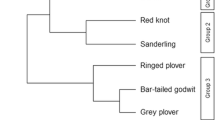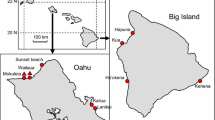Abstract
Southwestern Atlantic estuaries (Southern Brazil to Northern Patagonia, Argentina) are characterized by the presence of an intertidal burrowing crab Chasmagnathus granulata. This crab species is an important bioturbator which lives in large assemblages and excavates semi-permanent burrows that affect sediment characteristics. Our observations showed that distribution of the crabs in the Mar Chiquita coastal lagoon, Argentina (37°45′S, 57°26′W) affected habitat use and feeding success of migratory shorebirds. During the migratory season the two-banded plover (Charadrius falklandicus) foraged more frequently inside crab beds, and yellowlegs (Tringa flavipes and T. melanoleuca) fed more freqeuntly outside crab beds. Focal observations on the feeding behavior of the white-rumped sandpiper (Calidris fuscicollis) and the two-banded plover inside and outside crab beds showed that the plover was a visual searcher and captured more prey inside crab beds, and the white-rumped sandpiper was a tactile feeder. Although consumption rates (prey min−1) did not differ between sites, their efficiency (prey probe−1) inside crab beds was less. These differences were probably related to changes in sediment characteristics and prey behavior, which vary with crab activity. Burrowing crabs alter the suitability of intertidal habitats used by shorebirds in southwestern Atlantic estuaries. We believe that the same process could be occurring with other burrowing curstaceans such as thalassinidean shrimps in other estuaries of the world and could have important implications for management of flats for shorebirds. *** DIRECT SUPPORT *** A01BY090 00007
Similar content being viewed by others
Literature Cited
Bortolus, A. and O. Iribarne. 1999. Effects of the SW Atlantic burrowing crab Chasmagnathus granulata on a Spartina salt marsh. Marine Ecology Progress Series 178:78–88.
Boschi, E. E. 1964. Los Crustaceos Decapodos Brachyura del litoral Bonaerense. Boletin del Instituto de Biologia Marina 6:1–99.
Botto, F. and O. Iribarne. 1997. The effect, of the SW Atlantic burrowing crabs Chasmagnathus granulata and Uca uruguayensis on the sediment composition and bedload transport of estuarine environments. VII Congreso Latinamericano sobre Ciencias del Mar. Santos, Brazil.
Botto, F. and O. Iribarne. 1999. Effect of the burrowing crab Chasmagnathus granulata on the benthic community of a SW Atlantic coastal lagoon. Journal of Experimental Marine Biology and Ecology 241:263–284.
Botto, F., O. Iribarne, M. M. Martinez, K. Delhey, and M. Carrete. 1998. The effect of migratory shorebirds on the benthic species of three southwestern Atlantic Argentinean estuaries. Estuaries 21:700–709.
Branch, G. M. and A. Pringle. 1987. The impact of the sand prawn Callianassa kraussi Stebbing on sediment turn-over and the bacteria, meiofauna, and the benthic microflora. Journal of Experimental Marine Biology and Ecology 107:219–235.
Brenchley, G. A. 1981. Disturbance and community structure: An experimental study of bioturbation in marine soft-bottom environments. Journal of Marine Research 39:767–790.
Brush, T. 1995. Habitat use by wintering shorebirds along the lower laguna Madre of South Texas. Texas Journal of Science 47: 170–190.
Bryant, D. M. 1979. Effects of prey density and site character on estuary usage by overwintering waders (Charadrii). Estuarine Coastal and Marine Science 9:369–384.
Colwell, M. A. and S. L. Landrum. 1993. Nonrandom shorebird distribution and fine-scale variation in prey abundance. The Condor 95:94–103.
Esselink, P. and L. Zwarts. 1989. Seasonal trend in burrow depth and tidal variation in feeding activity of Nereis diversicolor. Marine Ecology Progress Series 56:255–269.
Gerritsen, A. F. C. and Y. M. Van Heezik. 1985. Substrate preference and substrate related foraging behaviour in three Calidris species. Netherlands Journal of Zoology 35:671–692.
Goss-Custard, J. D. 1984. Intake rates and food supply in migrating and wintering shorebirds, p. 233–277. In G. Burger and B. L. Olla (eds.), Volume 6, Shorebirds: Migration and Foraging Behavior. Plenum Press, New York.
Goss-Custard, J. D. 1985. Foraging behavior of wading birds on the carrying capacity of estuaries, p. 169–189. In R. M. Sibly and R. H. Smith (eds.), Behavioural Ecology. Blackwell Scientific Publications, Oxford, England.
Grant, J. 1984. Sediment microtopography and shorebird, foraging. Marine Ecology Progress Series 19:293–296.
Iribarne, O., A. Bortolus, and F. Botto. 1997. Between-habitat differences in burrow characteristics and trophic modes in the south western Atlantic burrowing crab Chasmagnathus granulata. Marine Ecology Progress Series 155:137–145.
Iribarne, O. and M. M. Martinez. 1999. Predation on the southwestern Atlantic fiddler crab (Uca uruguayensis) by migratory shorebird (Phivialis dominica, P. squatarola, Arenaria interpres, and Numenius phaeopus). Estuaries 22:47–54
Levinton, J. S. 1989. Deposit, feeding and coastal oceanography, p. 1–23. In G. Lopez, G. Taghon, and J. Levinton, (eds.), Ecology of Marine Deposit Feeders. Lecture Notes on Coastal and Estuarine Studies. Springer-Verlag, New York.
Morris, D. W. 1987. Ecological scale and habitat use. Ecology 68: 362–369.
Morrison, R. I. G. and R. K. Ross. 1989. Atlas of Neartic shorebirds on the coast of South America. Canadian Wildlife Serice Special Publication 2:131–323.
Mouritsen, K. N. and K. T. Jensen. 1992. Choice of microhabitat in tactile foraging dunlins Calidris alpina: The importance of sediment penetrability. Marine Ecology Progress Series 85: 1–8.
Myers, J. P. 1980. The pampas shorebird community: Interaction between breeding and nonbreeding members, p. 37–41. In J. A. Keast and E. S. Morton (eds.), Migrant Birds in the Neotropics: Ecology, Behavior Distribution and Conservation. Smithsonian Institution Press, Washington, D.C.
Myers, J. P. and L. P. Myers., 1979. Shorebirds of coastal Buenos Aires Province, Argentina. Ibis. Marine Ecology Progress Series, 121:186–200.
Myers, J. P., S. L. Williams, and F. A. Pitelka. 1980. An experimental analysis of prey availability for sanderlings (Aves: Scolopacidae) feeding on sandy beach crustanceans. Canadian Journal of Zoology 58:1564–1574.
Narosky, T. and D. Yzurieta. 1987. Birds of Argentina and Uruguay. A field guide. Asociation Ornitologica, del Plata. Buenos Aires, Argentina.
Neter, J., W. Wasserman, and M. H. Kutner. 1990. Applied Linear Models, Regression, Analysis of Variance, and Experimental Designs. R. D. Irwin Inc., Boston, Massachusetts.
Nickell, L. A. and R. J. A. Atkinson. 1995. Functional morphology of burrows and trophic modes of three thalassinidean shrimp species, and a new approach to the classification of thalassinidean burrow morphology. Marine Ecology Progress Series 128:181–197.
Palomo, G. and O. Iribarne. In press. Sediment remotion resulted from polychaete feeding may reduce bedload transport. Bulletin of Marine Science.
Pienkowski, M. W. 1981. How foraging plovers cope with environmental effects on invertebrate behaviour and availability, p. 179–192. In N. V. Jones and W. J. Wolff (eds.), Feeding and Survival Strategies of Estuarine Organisms. Plenum Press, New York.
Piersma, T. J. Van Gils, P. De Geoij, and J. Van Deer Meer. 1995. Holling's functional response model as a tool to link the food-finding mechanism of a probing shorebird with its spatial distribution. Journal of Animal Ecology 64:493–504.
Posey, M. H. 1986. Changes in a benthic community associated with dense beds of a burrowing deposit-feeder, Callianasa californiensis. Marine Ecology Progress Series 31:15–22.
Posey, M. H., B. R. Dumbauld, and D. A. Armstrong. 1991. Effects of a burrowing mud shrimp, Upogebia pugettensis (Dana), on abundance of macro-infauna. Journal of Experimental Marine Biology and Ecology 148:283–294.
Puttick, G. M. 1979. Foraging behaviour and activity budget of Curlew Sandpipers. Ardea 67:111–122.
Quammen, M. L. 1984. Predation by shorebirds, fish and crabs on invertebrates on intertidal mudflats: An experimental test. Ecology 65:529–537.
Rhoads, D. C. and D. K. Young. 1970. The influence of deposit feeding organisms on sediment stability and community trophic structure. Journal of Narine Research 28:150–178.
Rowden, A. A. and M. B. Jones. 1995. The burrow structure of the mud shrimp Callianasa subterranea (Decapoda: Thalassinidea) from the North Sea. Journal of Natural History 29:1155–1165.
Spivak, E., K. Anger, T. Luppi, C. Bas, and D. Ismael. 1994. Distribution and habitat preferences of two grapsid crab species in Mar Chiquita Lagoon (Province of Buenoas Aires, Argentina). Helgolander, Meeresuntersuchungen 48:59–78.
Suchanek, T. H. 1985. Thalassinidean shrimp burrows: Ecological significance of species-specific architecture. Proceedings of the Fifth International Coral Reef Congress, Tahiti, 5:205–210.
Swinbanks, D. D. and J. L. Luternauer. 1987. Burrow distribution of thalassinidean shrimp on a Fraser delta tidal flat, British Columbia. Journal of Paleontology 61:315–332.
Wilson, W. H. 1991. The foraging ecology of migratory shorebirds in marine soft-sediment communities: The effects of episodic predation on prey populations. American Zoologist 31: 840–848.
Witbaard, R. and G. C. A. Duineveld. 1989. Some aspects of the biology and ecology of the burrowing shrimp Callianassa subterranea (Montagu) (Thalassinidea) from the southern North Sea. Sarsia 74:209–219.
Zar, J. H. 1984. Biostatistical Analysis. Prentice-Hall, Inc., Englewood Cliffs, New Jersey.
Zwarts, L. and J. H. Wanink. 1991. The macrobenthos fraction accessible to waders may represent marginal, prey. Oecologia 87:581–587.
Author information
Authors and Affiliations
Corresponding author
Rights and permissions
About this article
Cite this article
Botto, F., Palomo, G., Iribarne, O. et al. The effect of Southwestern Atlantic burrowing crabs on habitat use and foraging activity of migratory shorebirds. Estuaries 23, 208–215 (2000). https://doi.org/10.2307/1352828
Received:
Accepted:
Issue Date:
DOI: https://doi.org/10.2307/1352828




